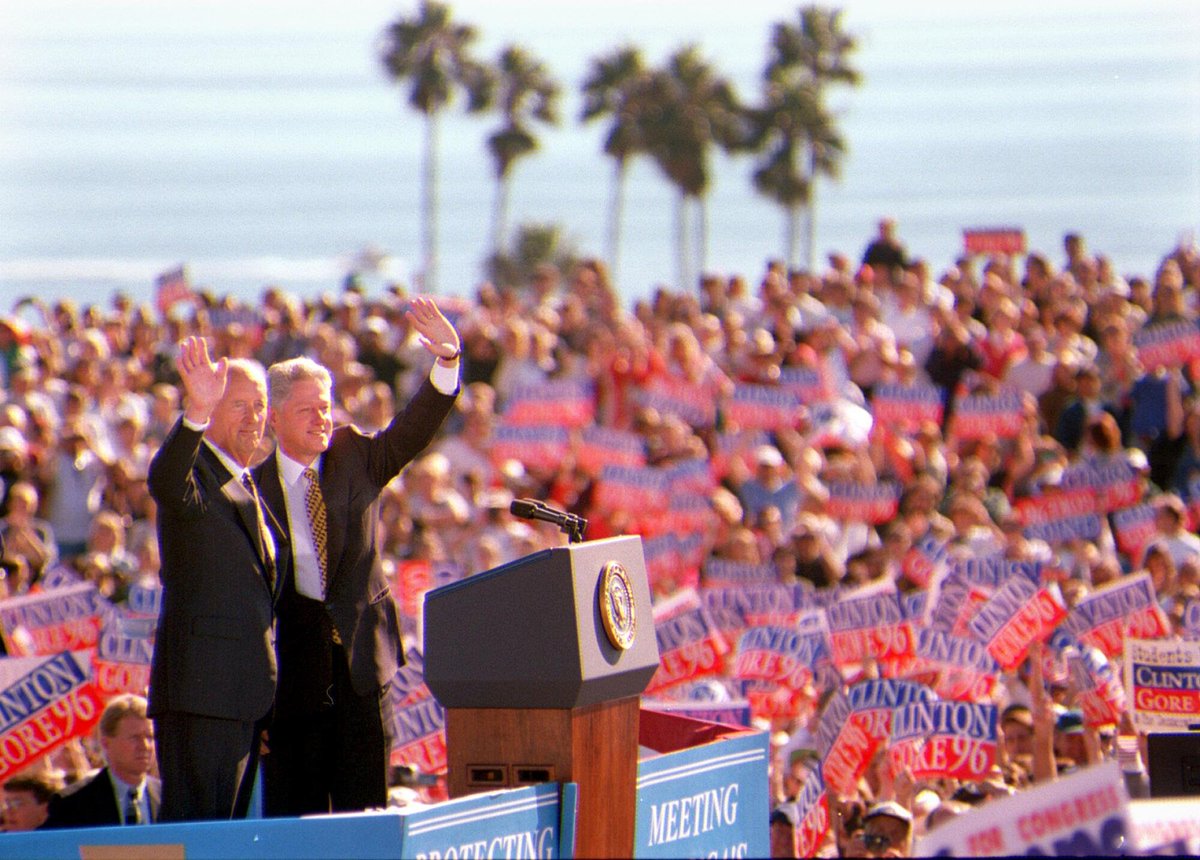Bill Clinton was re-elected in 1996 by 8.5 points, the most resounding victory by a Democrat since LBJ.
I don’t think people realize what a stick in the eye his campaign was to liberal Democratic orthodoxy.
A 🧵and appreciation of Clinton’s 🐐 ‘96 re-election.
I don’t think people realize what a stick in the eye his campaign was to liberal Democratic orthodoxy.
A 🧵and appreciation of Clinton’s 🐐 ‘96 re-election.

After losing the 1994 midterms, Clinton was in a political funk, written off for dead.
Then he hired Dick Morris, the party-hopping Republican who helped Clinton win his 1982 comeback bid in Arkansas.
Soon after, Clinton had his groove back. nytimes.com/1995/07/01/us/…

Then he hired Dick Morris, the party-hopping Republican who helped Clinton win his 1982 comeback bid in Arkansas.
Soon after, Clinton had his groove back. nytimes.com/1995/07/01/us/…

One of Morris’s first moves was to launch an ad blitz in the summer of 1995 sixteen months before the election. The issue: crime.
Clinton seamlessly blended talk of gun control with support for more police, a both/and strategy that eludes Democrats today.
Clinton seamlessly blended talk of gun control with support for more police, a both/and strategy that eludes Democrats today.

Morris’s strategy became known as triangulation, written up in this November 1995 Lloyd Grove column.
This positioned Clinton above the fray, distinct from unpopular Gingrich Republicans AND the Democratic left. washingtonpost.com/archive/lifest…

This positioned Clinton above the fray, distinct from unpopular Gingrich Republicans AND the Democratic left. washingtonpost.com/archive/lifest…

The biggest sign of the positioning Clinton would adopt during the campaign came during the 1996 State of the Union address, when he declared “The era of big government is over.” Clinton endorsed a balanced budget and got it done in his second term.
At the same time, the president and his surrogates continued to distance themselves from their party’s soft on crime image.
Here’s Hillary Clinton talking about “superpredators” on January 28, 1996.
Here’s Hillary Clinton talking about “superpredators” on January 28, 1996.
Clinton’s positioning on crime and immigration would be unthinkable for a Democrat today.
Consider this clip from his 1995 State of the Union, where he talks about the need to stop illegal aliens, saying they take jobs and social services from Americans.
Consider this clip from his 1995 State of the Union, where he talks about the need to stop illegal aliens, saying they take jobs and social services from Americans.
The signature of the Morris triangulation campaign was a series of “micro-initiatives” to pitch Clinton to culturally conservative voters concerned about the decline of traditional values.
In February 1996, Clinton came out for school uniforms in public schools.
In February 1996, Clinton came out for school uniforms in public schools.

And Clinton endorsed a V-chip installed into TV sets to allow parents to block violence and smut.
V-chips were included in the 1996 Telecommunications Act he signed into law, which also banned Internet porn (this provision was later struck down by the courts).
V-chips were included in the 1996 Telecommunications Act he signed into law, which also banned Internet porn (this provision was later struck down by the courts).

The biggest legislative accomplishment of 1996 was welfare reform, an issue pushed relentlessly by the Republican Congress.
A Stick. In. The. Eye. to the left and yet another example of Clinton swiping an issue from out under the Republicans’ noses.
politico.com/story/2018/08/…
A Stick. In. The. Eye. to the left and yet another example of Clinton swiping an issue from out under the Republicans’ noses.
politico.com/story/2018/08/…

Dick Morris’s strategy would outlast Morris on the campaign.
During the Democratic convention, his affair with a prostitute was revealed, and he resigned.
But Clinton’s remaining advisers stuck with the plan, concluding why fix it if it ain’t broke? latimes.com/archives/la-xp…
During the Democratic convention, his affair with a prostitute was revealed, and he resigned.
But Clinton’s remaining advisers stuck with the plan, concluding why fix it if it ain’t broke? latimes.com/archives/la-xp…
In the dead of night of September 20th, just weeks before the election, Clinton signed the Defense of Marriage Act, establishing marriage as between a man and a woman for the purposes of federal law. 

While Clinton didn’t go out of his way to tout DOMA with a huge bill signing ceremony, his campaign bragged about it in stealth ads on Christian radio.
Audio was so hard to come by it was only uncovered by @KFILE in 2016. cnn.com/2016/10/10/pol…
Audio was so hard to come by it was only uncovered by @KFILE in 2016. cnn.com/2016/10/10/pol…
@KFILE The election was effectively over long before Labor Day. Clinton held a consistent lead over Bob Dole, the Senate majority leader, and then the oldest major party nominee at 73.
Clinton drove home the age issue with his slogan, “Building a Bridge to the 21st Century.”
Clinton drove home the age issue with his slogan, “Building a Bridge to the 21st Century.”

@KFILE Clinton’s early ads against “DoleGingrich” were brutal. His attacks hit on normal Democratic themes like abortion and GOP budget cuts, but then pivoted towards his support for proto-Republican ideas like balanced budgets and tax cuts.
Another ad hit Dole from the right for raising taxes. “35 years in Washington, 35 years of higher taxes.”
Many of Clinton’s fall ads were a carbon copy of Ronald Reagan’s “Morning in America.” In this ad, Clinton leads off with a promise to lead the country “toward a future where government is smaller.”
@KFILE And this one has become a favorite in recent years, particularly Clinton’s proposal for a death penalty for drug kingpins, positioning that Josh Gottheimer begged Nancy Pelosi to adopt after the “defund the police” fiasco in 2020.
@KFILE Clinton was successful not only for achieving a huge electoral victory, but for the broad coalition he put together. There was no education polarization among whites either time he ran and he did well in big chunks of rural America. 

@KFILE A Pew survey late in the campaign revealed Clinton’s strength: He unified all parts of the Democratic Party, who acquiesced to his moves to the center, while fracturing Republicans, including “economically squeezed populist conservatives.” pewresearch.org/politics/1996/…
@KFILE Many of the conservatives who voted for Bill Clinton in 1996 switched to Donald Trump in 2016, especially in the Midwest.
It’s why MAGA remembers Clinton more fondly than other Democratic presidents.
It’s why MAGA remembers Clinton more fondly than other Democratic presidents.
https://x.com/echeloninsights/status/1633846206836408322?s=46&t=9suURK7GsN7lYHR2rm-v7Q
@KFILE The Clinton '96 strategy has fallen out of favor lately, a victim of Internet fundraising, ideological sorting, and the strength of primary electorates.
But I think the success of this approach is timeless, and if an incumbent president ran with it today, they would slay.
But I think the success of this approach is timeless, and if an incumbent president ran with it today, they would slay.
@KFILE Clinton '96 was peak Median Voter Theorem. Relentlessly seize the middle ground and swipe your opponents' issues to Hulk-smash them politically.
It's why Clinton ended his term as the most popular president in modern times and survived impeachment.
It's why Clinton ended his term as the most popular president in modern times and survived impeachment.
@KFILE Democrats and Republicans both could learn a lot from 1996 and consistently ask: WWWJCD?
But Biden won't do it, as shown by his walkback of "illegal," because The Groups are just too strong.
But Biden won't do it, as shown by his walkback of "illegal," because The Groups are just too strong.
• • •
Missing some Tweet in this thread? You can try to
force a refresh













